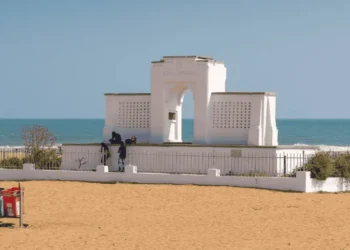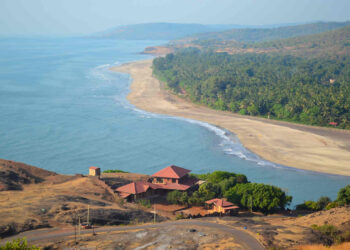The Virupaksha Temple is a holy kshetra for Lord Shiva, worshipped as Virupaksha, located in Hampi, Karnataka. This ancient shrine, set by the Tungabhadra River, is one of India’s oldest functioning temples and a UNESCO World Heritage Site, part of Hampi’s Vijayanagara ruins. Covering about 10 acres, its towering gopuram, carved halls, and sacred courtyards draw pilgrims from across India and beyond. The temple is often considered as a shining example of Karnataka’s spiritual and deep religious heritage.
Legend of the Temple
The legends tied to the Virupaksha Temple are very interesting. One story tells of Pampa, a local river goddess and daughter of Brahma, who fell in love with Shiva. She prayed intensely by the Tungabhadra, seeking him as her husband. Shiva, pleased with her devotion, took the form of Virupaksha, meaning “one with unique eyes,” and married her. The temple, named after him, became a sacred site, with Pampa worshipped as his consort. The nearby Pampasarovar lake is linked to her penance, and devotees believe bathing there cleanses sins.
Another tale connects the temple to the sage Vidyaranya, a 14th-century Vijayanagara saint. He saw Shiva appear as Virupaksha in a vision, guiding the founding of the Vijayanagara Empire. The temple became the empire’s spiritual center, with kings seeking Shiva’s blessings before battles.
History of Virupaksha Temple
The temple’s history goes back to the 7th century. Inscriptions from the Chalukya period mention it as a key Shiva shrine, though worship here may have started earlier, tied to local traditions. The current structure grew over centuries, with major additions by the Vijayanagara kings from the 14th to 16th centuries. The Tamil Saiva Siddhanta texts and inscriptions also note its importance as a Saiva center.
The Chalukya kings, from the 6th to 8th centuries, began it with simple structures. The Rashtrakutas, in the 8th century, added carvings and halls. The Vijayanagara kings, especially Krishnadevaraya in the 16th century, made it grand, building the 160-foot gopuram, one of South India’s tallest, and expanding the courtyards. Stone records show they gave gold, land, and lamps to keep the temple thriving. By the 14th century, it was a busy hub, with traders, priests, and villagers supporting it, as old texts describe.
In the 1565 Battle of Talikota, Islamic invaders destroyed much of Hampi, but the Virupaksha Temple was spared, though some carvings were damaged. Priests hid idols to protect them. The Vijayanagara rulers’ successors, like the Aravidu dynasty, later restored rituals in the temple. In the 1700s, the Marathas held Hampi briefly, followed by the British in 1800 still the temple stayed strong. By 1856, the British oversaw it, and in 1947, Karnataka’s government took charge, with the HR&CE Board managing it today. The temple’s spiritual history lives in inscriptions and songs by saints like Purandara Dasa, whose hymns praise Virupaksha. Its role as a Saiva center keeps it vital.
Architecture of the Temple
The Virupaksha Temple is built in Dravidian style, covering 10 acres. Its main gopuram, 160 feet tall, is covered with carvings of gods, dancers, and stories from the Ramayana and Mahabharata. Smaller gopurams and courtyards lead to the sanctum, where the Virupaksha lingam, said to be self-born, sits in a simple shrine. Pampa’s shrine, as Bhuvaneshwari, is nearby.
The Ranga Mandapa, a Vijayanagara hall, has 38 pillars carved with warriors and yalis (mythical lions). The Kanakagiri Gopura, another entrance, shows Krishna’s tales. A sacred pool, the Manmatha Tank, reflects the gopuram. Shrines for Ganesha, Subrahmanya, and Hanuman are scattered around. Wall paintings from the 19th century, restored recently, show Shiva’s forms, making every corner a glimpse of history.
Religious Significance and Festivals
For Saivites, the temple is a key place, tied to Shiva’s divine presence. People pray for peace or success, offering flowers or joining abhishekam, feeling Shiva’s grace in the river’s flow.
As a major Saiva shrine, it’s a top pilgrimage site, named in Chalukya and Vijayanagara records. Its role in Saiva tradition, shaped by saints and kings, draws those seeking the divine. The temple’s link to Vidyaranya and the Vijayanagara Empire adds a layer of royal reverence.
Festivals like Hampi Utsav, in November, celebrates with music, dance, and a chariot procession for Virupaksha. Maha Shivaratri has night-long prayers and river baths. The Phalapuja, in December, marks Shiva and Pampa’s wedding with processions. Six daily rituals, from 5 AM to 9 PM, led by priests, keep the temple’s rhythm with chants, oil lamps, and offerings like rice and ghee.
The temple is a big part of Karnataka’s culture. Songs by Purandara Dasa and Kanakadasa, tied to Hampi, shape Saiva and Bhakti traditions. Festivals bring Carnatic music and classical dance, keeping Karnataka’s arts alive, and the carvings show life from Vijayanagara times. The temple’s riverside setting, amid Hampi’s ruins, ties it to Karnataka’s history as a trade and spiritual hub.
Today, it pulls visitors from everywhere around the world. Hampi is just 350 km from Bengaluru or 13 km from Hospet, easy by bus or train. Pilgrims often visit nearby sites like the Vittala Temple, making it a broader trip.
Conclusion
The Virupaksha Temple is an intricate part of Karnataka’s culture. Its legend of Pampa’s devotion, its history through dynasties and trials, its intricate carved beauty, and deep Saiva faith of the devotees make it a living kshetra. The Virupaksha Temple calls those devoted to Lord Shiva, thousands in number, from all over India, whose divine presence can be felt throughout the temple complex.











